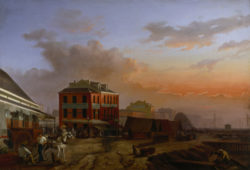Louis Develle
Louis Develle, a French artist active in New Orleans, was best known for his set designs at the Théatre d’Orléans.

Courtesy of The Historic New Orleans Collection
French Market and Red Store. Develle, Louis Dominique Grandjean (Artist)
Louis Dominique Grandjean Develle, an artist active in New Orleans from 1829 until his death in 1868, was best known for his set designs at the Théatre d’Orléans. Formerly located on Orleans Street between Royal and Bourbon streets in the French Quarter, the theater was widely attended by sophisticated French Creoles. French operas often had their North American premieres in the Theatre d’Orléans, with top European performers and sets designed by Develle.
Born in 1799 in Paris, France, Develle was likely named after his father, who may have changed the family name from Filbert to Develle. A student of Pierre-Luc-Charles Ciceri, who designed Parisian opera sets, Develle decorated Rheims Cathedral for the 1824 consecration of French King Charles X. He then worked as set designer in Le Havre for three years. In 1829 Develle arrived in New Orleans, having accepted a position as set designer at the Théatre d’Orléans. He had a son, Louis Develle, who may have also worked briefly in set design.
The 1830s and 1840s marked the heyday of operatic performance in New Orleans. French drama and opera were shown primarily at the Théatre d’Orléans, while the St. Charles Theatre staged Italian opera. The strong repertoire of the Théatre d’Orléans included Halévy’s La Juive, Meyerbeer’s Les Hugenots, a French version of Verdi’s Jérusalem, and others like Robert le Diable, Les Trois Mousquetaires, and Les Martyrs—all performed before Develle’s sets. They were described as “splendid” and “magnificent” in the local press—with draftsmanship compared to that of French artist Jacques-Louis David—and noted for their precise portrayal of perspective. In the nineteen seasons between 1840 and 1860, the theater produced 109 operas by thirty-five different major and minor composers, comprising 1,550 performances. Within this rich musical milieu, Deville’s sets, like the performers, consistently received top billing, and in 1846 they prompted two curtain calls.
Popular and modest, Develle was frequently honored at benefits, customary during this period, which allowed him to return to France during the off-season, as did many wealthy New Orleanians. New Orleans’s opera troupe and sets were occasionally transported to New York and Philadelphia in the summer, introducing French opera to those cities.
Develle also worked as a painter and painting teacher; his best-known pupil was Léon Pomarède. In 1842 Develle decorated St. Louis Cathedral in New Orleans for the memorial mass in honor of Fernand, eldest son of Louis Philippe, King of France. Also, he collaborated with Parisian artist Auguste de Chatillon to depict the battle of Resaca de la Palma during the Mexican-American War. The artists reportedly set their easels at the battlefront, capturing the ferocity of combat. The painting, completed at Destrehan Plantation, was unveiled at the St. Louis Hotel ballroom in New Orleans in 1847 and was reportedly sold to a patron in Washington, D.C.
In 1850 Develle’s panorama of Jerusalem was shown for a year at the Théatre d’Orléans. He died in 1868. Today, at The Historic New Orleans Collection, Develle’s painting The Red Store hints at the rich scenery that graced the Théatre d’Orléans during the golden age of opera in the city.
